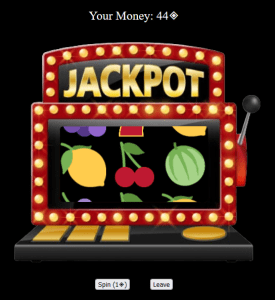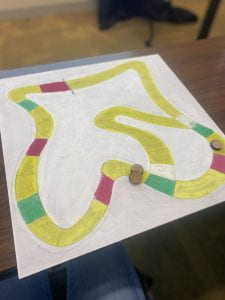By Ruby Harkness
Link for all rules and directions:
Artist’s Statement:
Sprout is a card game that comments on environmental awareness and helping others. The game starts as collaborative, but eventually forces players to be selfish, which I thought was a really interesting progression. The main goal of Sprout is to grow your plant faster than everyone else, but if one person’s plant “dies” or reaches 0 growth points, everyone loses.
The idea of growing a plant was a core value of Sprout from the start, however, the mechanics switched up a lot through the design process. Originally the game was designed to have 4 different cards with different abilities, but for simplicity, the final version only has 2 different card types. The game also originally was more of a luck based game, but after talking with others in the class it seemed like a strategy based game would be more fun. The first play test included the two card types and the plant models, which are the same as the final version. However, after the first play test, I realized that the game was too hard. Multiple people were out too fast causing everyone to lose the game in around 3 rounds. We tweaked this by creating a “pass go” system where every time a round ends, every player adds one growth to their plant. This seemed to help the game flow a lot better and on the next play test the game went on for a long time. Cards were also shuffled to disperse different events more evenly.
Sprout’s commentary on environmental awareness was intended, but after we were talking about how Sprout also acts as a commentary on socialism. The beginning of the game forces players to share their winnings to help keep everyone alive. Sharing resources was a big part of the early game. People were forced to be willing to give to each other. Late game is when people got competitive because nobody’s sprout was close to dying. It was super interesting to see people go from sharing and being very willing to give up resources to wanting to keep everything they had to themselves to get ahead of other players. The start of the game was very collaborative, but the collaboration eventually fell apart when people realized they were not forced to keep others alive anymore.
I think Sprout gets a lot of inspiration from indie farming games like Stardew Valley, a game based around the idea of the player “taking care” of something. I think the tactile element of Sprout can be compared to a game like Battleship. Both use a very clear visual and tactile way of keeping score. The scorekeeping models were also fully inspired by the model in “Grow: The Organic Building Game” which we talked about in class. As an art game, I think Sprout could connect to the DADA movement, providing an interesting commentary on environmental issues.
Images:














